30
March 2001
A Brimstone
butterfly is on the wing in North Lancing (urban area) with the first decent
sun for weeks. (TQ
182 056)
Lancing
Nature & History - April Newsletter (by Ray Hamblett)
UK-LEPS
Discussion Group (for Butterflies and Moths)
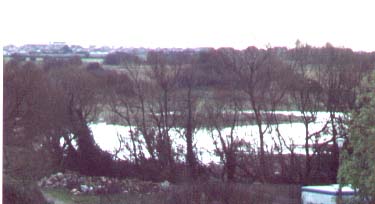
24
March 2001
A
dry day but the ground is absolutely saturated almost everywhere, the standing
water on the Mash Barn, Lancing, is greater than it has been before this
winter. Squelchy Southwick Green is being pumped clear of flood water.
21
March 2001
Not
exactly spring, but still a pleasant still day at 10° C and little
sign of the mini-blizzard of yesterday. The water was still gushing from
the downs and draining from the airport into the surrounding ditches, but
there was no photographic sunlight, the crowds were still dark to the north
above Mill Hill.
Work
has begun on repairing the flint wall of the Old
Fort of Shoreham Beach (constructed c. 1857) by Dave Smith of Flintman
of Lewes. The lizards*,
well
known to Shoreham children, have been displaced from their prime
holes in the wall, and have skittered off to new habitats. (TQ
234 044)
Full
Story and Photograph
Flintman
on Flint (Link)
*These
have now been identified as Wall Lizards Podarcis
muralis.
20 March
2001
The
first day of spring is greeted by a heavy flurry of sleet driven almost
horizontally by a strong east wind. The sleet was heavy and continuous
for the whole of daylight without remission, but it was still above freezing
and in the town of Shoreham it all melted on
contact with the ground. As I looked out of my window, the view of the
downs
was obscured by dreadful conditions. By mid-afternoon, the tops of cars
were sprinkled with a layer of snow, so the downs were likely to covered.
By late afternoon the snow began to settle in town but only for a short
time before it turned to heavy slush, and as conditions eased for a brief
interlude, I could see the downs were only lightly sprinkled with snow.
By the evening rush hour and dusk it was more rain than sleet.
Vernal
Equinox Link
BMLSS
Tides Page
18
March 2001
Crows
are collecting twigs from Beech trees for their nests in the Pines, and
Magpies
are building their nests in the gardens of Lancing.
17
March 2001
Four Avocets
made a visit to the mudflats south of Old Shoreham Toll bridge. This bird
has an upturned long beak. These distinctive birds are rare visitors to
Shoreham. (I have seen one on the beach at
Worthing in March once only: AH).
16
March 2001
The
first immigrant Wheatears
make their landfall near the Widewater Lagoon.
9
March 2001
The
Oystercatchers
can be found on the River Adur mud flats amongst
the mussel beds on the low spring tides.
28
February 2001
Food
& Mouth Disease Restrictions
The
Food
& Mouth Disease regulations have come into force to empower Local
Authorities to close footpaths and rights of way. Notices have been put
on in the Adur Valley, with good reason. The Police have made sure they
are enforced and they have been complied with.
MAFF
Information Page
Public
Rights of Way and Foot & Mouth Disease
WSCC
Information
ESCC
Information
25
February 2001
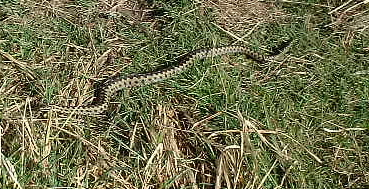
An Adder
basked in the sun on the chalkpit lane near Lancing Ring as the sprinkling
of overnight snow gradually melted away. This is the only poisonous snake
found on mainland Britain and is also known as the Common Viper. It hibernates
during the winter.
Lancing
Nature & History - February Newsletter
The was a layer of snow
on the downs above Sompting.
Link
to a panoramic photograph by Paul Parsons (Adur Forum members only)
Lancing
Ring Photographic Gallery for February
2*
February 2001
Two
Mute
Swans landed on the A27 Flyover in the
early morning fog and caused a traffic hold-up on this busy road.
20
February 2001
A Grey
Wagtail was spotted on the shingle beach
adjacent to Beach Green, Lancing. This bird is seen occasionally every
winter near water and there is a very small breeding population in Sussex.
19
February 2001
A
flash of red tail (it could be mistaken for a red breast in flight) indicated
the male Black Redstart
flitting
between the beach huts south of Beach Green, Shoreham
Beach. It perched pipit-like on a metre-high pole sticking out of the
shingle beach where it looked black silhouetted against the morning sky.
A couple of the brownish female birds were also reported on the same day.
14
February 2001
 For
the first time for many years a good haul of the Brown
Shimp, Crangon crangon, was reported from the shallow seas
off Shoreham-by-Sea, Sussex.
Gallons of shrimps were collected in a push net at low tide. No Weevers
were netted.
For
the first time for many years a good haul of the Brown
Shimp, Crangon crangon, was reported from the shallow seas
off Shoreham-by-Sea, Sussex.
Gallons of shrimps were collected in a push net at low tide. No Weevers
were netted.
Report
by Peter Murphy
c. 14
February 2001
The first Common
Frog entered a pond in The Drive, Shoreham, (TQ
219 063), and laid a large clump of frog spawn.
12
February 2001
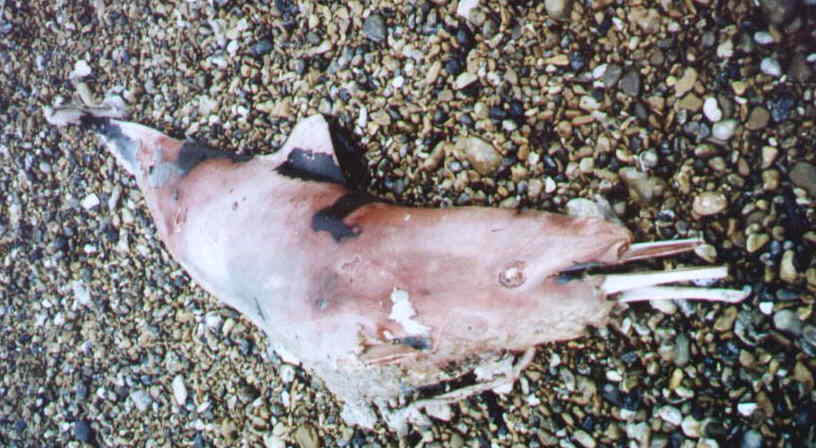
Photograph
by Steve Savage (Sea Watch Foundation)
Click
on the flipper for a close-up
Two
badly decomposed Dolphins were washed up on Shoreham
Beach, Sussex. They were badly decomposed but were probably Common
Dolphins, Delphinus
delphis. A Porpoise,
just over a metre long, was washed at nearby Worthing.
Sussex
Dolphins
Sussex
Cetaceans 2001
Sussex
Sea Watch Foundation News 2001
10
February 2001
Ray
Hamblett reports a Red Admiral
Butterfly from his garden in south Lancing.
8 February
2001
After
several days of rain; the ground is saturated everywhere, especially Lancing
Ring. West
Way, Lancing was flooded, as expected up to the edge of the gardens, but
this is still not as bad as it has been in the past.
National
Floodline, Tel: 0845 988 1188

Empty egg cases of the Undulate
Ray (left) and Dogfish (right) are found washed up on the strandline by
Andy
Horton and Ray
Hamblett.
Mermaid's
Purse (BMLSS Information)
4 February
2001
Jackdaws
accompany the flocks of Crows in the Buckingham Park area of Shoreham.
There are lot of birds around, especially Robins and Blue Tits and little
brown birds in the tree tops.
 3
February 2001
3
February 2001
The
sea anemone Diadumene cincta
has been identified and photographed by Paul Parsons off Worthing at a
depth of 3 metres and they possibly occur off Shoreham as well. It is a
small sea anemone that has probably overlooked before or incorrectly identified.
The colony found was very small. It needs to be picked out amongst the
background of the Lightbulb
Sea Squirts, Clavelina lepadiformis.
Photographs
Sea
Anemones (Link)
29
January 2001
Adur
World Oceans Day 2001
The
first meeting to discuss arrangements for this Adur Festival event.
Please
express any interest to:
Andy
Horton (British Marine Life Study Society)
Glaucus@hotmail.com
or
Natalie
Brahma-Pearl (Adur District Council)
natalie.brahma-pearl@adur.gov.uk
Adur
World Oceans Day 2001 web page
21
January 2001
A
small flock (at least 6 birds) of Long-tailed
Tits were seem amongst the lower branches
of the large Beech
trees in the Drive, Shoreham-by-Sea, during the steady rain that had drizzled
down for the whole day. These tiny birds (smaller than the Wren) have not
seen
in these trees before (my observations in 30 years).
The
Kestrel
that
was seen almost every day in Dolphin Road for years has not be seen hovering
over the allotments or railway embankment for over 6 months now.
19 January
2001
The
first flurries of snow, hardly anything, are seen in the late morning.
Ice
formed on the Lancing Ring Dewpond
(Ray Hamblett)
11 January
2001
Three
Red-breasted
Mergansers settle on Widewater
Lagoon. There have been reports of up to 7. In flight they seem nearly
as quick as Mallards.
 7
January 2001
7
January 2001
Several
hundred Long-spined Bullheads, Taurulus
bubalis, were found up washed on the strandline on Lancing beach, West
Sussex. This has has not been recorded before and could have been caused
by localised pollution. It
was breeding time for these small fish.
4
January 2001
The overnight rainfall at
Shoreham of 20 mm was the highest in England. Where is other places the
dangers of floods are receding, the water table is reaching high levels,
but not record levels, locally. In
October
2001 the rainfall was higher.
1 January
2001
An
oiled Gannet is reported from Widewater Lagoon.
This was the first sign of a much greater oil spill off the Sussex
coast with scores of oiled Guillemots
and other birds.
All
sightings of oiled birds should be sent to the RSPCA, Tel: 0300 1234 999.
1
January 2001
After
the dampest autumn on record, New Years Eve brought 8 hours+ of continual
rain up until and past midnight.
National
Floodline, Tel: 0845 988 1188



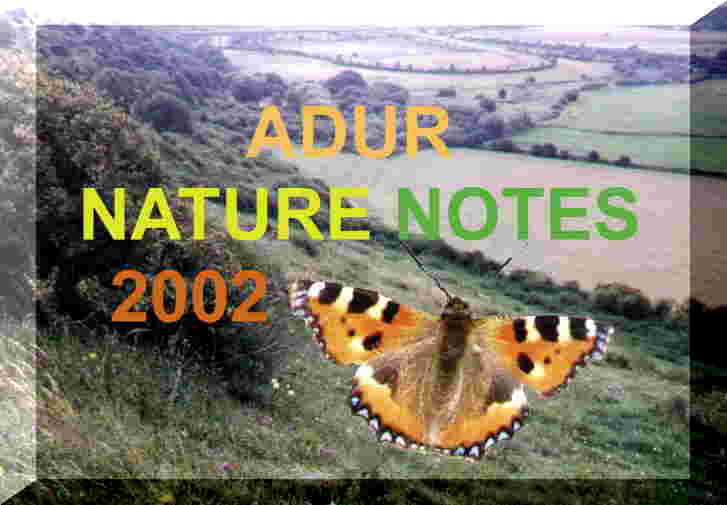
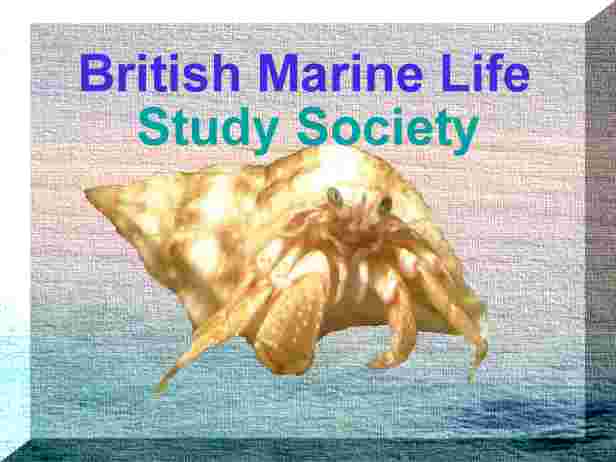


 3
February 2001
3
February 2001